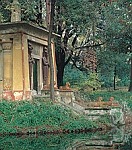| Comune: | Firenze |
| Via: | F. Stibbert, 26 |
 Nato a Firenze nel 1838 da una ricca famiglia anglosassone, educato in Inghilterra, Federico Stibbert inizia intorno al 1870 i lavori di restauro della Villa di Montughi e del suo bellissimo giardino. Tra coloro che si occuparono dei lavori di restauro spicca la figura di Giuseppe Poggi, insieme ad altri personaggi meno noti quali Gaetano Fortini, Gaetano Bianchi e Augusto Passaglia. Originariamente la villa, di proprietà della famiglia Davanzati doveva essere una casa di campagna di modeste dimensioni, come ci appare in un quadretto dipinto probabilmente dallo stesso Stibbert. Anche il giardino era piuttosto semplice con ampie aiuole all'italiana. Il rinnovamento del giardino si presenta con una struttura tipica di quello all'inglese, sia nella sistemazione delle piante, che in quella degli elementi architettonici. Di gusto romantico é l'inserimento del laghetto, sulle cui rive si specchia un piccolo tempio in stile neo-egizio, mentre il vialetto decorato da una fila di sculture e di busti classici é un elemento tipico del giardino italiano. Un tocco tardo romantico è dato dalle rovine di un cortile veneziano gotico, in marmo bianco, con una bellissima vera da pozzo al centro. Tipicamente fiorentine sono le numerose statue in terracotta, probabilmente eseguite dal Cantagalli, sparse all'interno del parco. Il giardino presenta una intricata serie di vialetti che salgono e scendono con arredi e angoli di riposo e di visuale, la vegetazione ad alto fusto è rappresentata da piante quali, pini, lecci, ippocastani, tigli, su cui svettano degli splendidi cipressi di cui alcuni, probabilmente, preesistenti al restauro dello Stibbert. Alla morte del colto proprietario la Villa e le raccolte di porcellane, mobilio, bronzetti, medaglie, armi antiche europee ed estremo-orientali, passarono al Comune di Firenze, che nel 1909 le aprì al pubblico come museo.
Nato a Firenze nel 1838 da una ricca famiglia anglosassone, educato in Inghilterra, Federico Stibbert inizia intorno al 1870 i lavori di restauro della Villa di Montughi e del suo bellissimo giardino. Tra coloro che si occuparono dei lavori di restauro spicca la figura di Giuseppe Poggi, insieme ad altri personaggi meno noti quali Gaetano Fortini, Gaetano Bianchi e Augusto Passaglia. Originariamente la villa, di proprietà della famiglia Davanzati doveva essere una casa di campagna di modeste dimensioni, come ci appare in un quadretto dipinto probabilmente dallo stesso Stibbert. Anche il giardino era piuttosto semplice con ampie aiuole all'italiana. Il rinnovamento del giardino si presenta con una struttura tipica di quello all'inglese, sia nella sistemazione delle piante, che in quella degli elementi architettonici. Di gusto romantico é l'inserimento del laghetto, sulle cui rive si specchia un piccolo tempio in stile neo-egizio, mentre il vialetto decorato da una fila di sculture e di busti classici é un elemento tipico del giardino italiano. Un tocco tardo romantico è dato dalle rovine di un cortile veneziano gotico, in marmo bianco, con una bellissima vera da pozzo al centro. Tipicamente fiorentine sono le numerose statue in terracotta, probabilmente eseguite dal Cantagalli, sparse all'interno del parco. Il giardino presenta una intricata serie di vialetti che salgono e scendono con arredi e angoli di riposo e di visuale, la vegetazione ad alto fusto è rappresentata da piante quali, pini, lecci, ippocastani, tigli, su cui svettano degli splendidi cipressi di cui alcuni, probabilmente, preesistenti al restauro dello Stibbert. Alla morte del colto proprietario la Villa e le raccolte di porcellane, mobilio, bronzetti, medaglie, armi antiche europee ed estremo-orientali, passarono al Comune di Firenze, che nel 1909 le aprì al pubblico come museo.
Born in Florence in 1838 into a rich Anglo-Saxon family, and educated in England, Federico Stibbert set about restoring the villa of Montughi and its splendid garden in 1870. One of the most important figures called in to work on the restoration project was Giuseppe Poggi, who worked in collaboration with less well-known figures such as Gaetano Fortini, Gaetano Bianchi and Augusto Passaglia. Originally, the villa, which was the property of the Davanzati family, must have been a country house of quite a modest size, as a picture probably painted by Stibbert himself suggests. The garden, too, would have been rather simple, with Italian-style flower-beds. The plants and flowers and architectural elements garden were reorganised in the English style. One particularly "romantic" new feature was the ornamental lake, on the banks of which stands a small neo-Egyptian temple reflected picturesquely in the water, while the avenue is decorated with a row of sculptures and classical busts in the typical Italian garden style. A late Romantic touch is provided by the ruins of a white marble Venetian Gothic courtyard, with a beautiful well-curb at the centre. Scattered around the park are numerous typically Florentine terracotta statues, probably sculpted by Cantagalli. The garden has an elaborate system of smaller avenues and pathways running up and down the garden, variously furnished with rest areas and look-out points. The trees are mainly pines, holm-oaks, horse chestnuts and limes, above which rise up some splendid cypress trees, which were probably already there even before Stibbert's restoration. When the villa's cultured owner died, the property, and its collections of porcelain, furniture, bronzes, medals, and ancient weaponry from Europe and the Far East became the property of the City of Florence, which in 1909 opened the house as a public museum.

